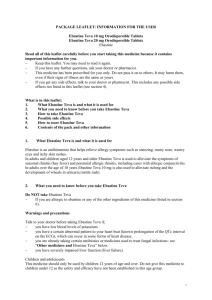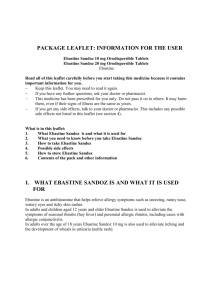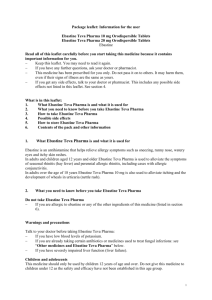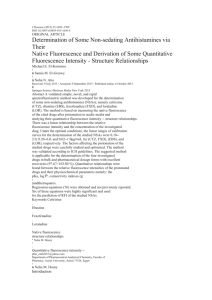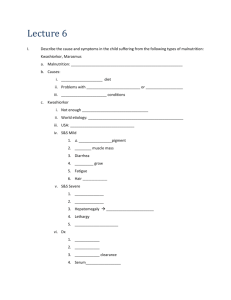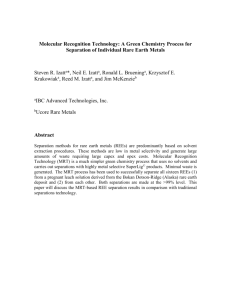Ebastine Teva Orodispersible Tablet ENG SmPC
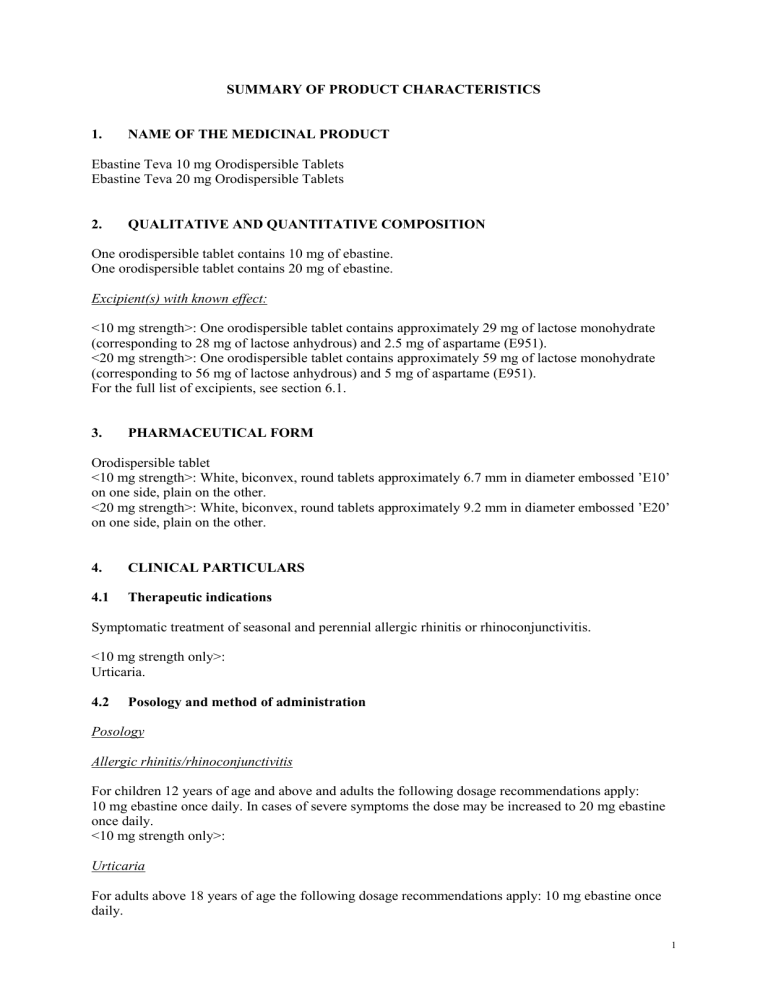
SUMMARY OF PRODUCT CHARACTERISTICS
1. NAME OF THE MEDICINAL PRODUCT
Ebastine Teva 10 mg Orodispersible Tablets
Ebastine Teva 20 mg Orodispersible Tablets
2. QUALITATIVE AND QUANTITATIVE COMPOSITION
One orodispersible tablet contains 10 mg of ebastine.
One orodispersible tablet contains 20 mg of ebastine.
Excipient(s) with known effect:
<10 mg strength>: One orodispersible tablet contains approximately 29 mg of lactose monohydrate
(corresponding to 28 mg of lactose anhydrous) and 2.5 mg of aspartame (E951).
<20 mg strength>: One orodispersible tablet contains approximately 59 mg of lactose monohydrate
(corresponding to 56 mg of lactose anhydrous) and 5 mg of aspartame (E951).
For the full list of excipients, see section 6.1.
3. PHARMACEUTICAL FORM
Orodispersible tablet
<10 mg strength>: White, biconvex, round tablets approximately 6.7 mm in diameter embossed ’E10’ on one side, plain on the other.
<20 mg strength>: White, biconvex, round tablets approximately 9.2 mm in diameter embossed ’E20’ on one side, plain on the other.
4. CLINICAL PARTICULARS
4.1 Therapeutic indications
Symptomatic treatment of seasonal and perennial allergic rhinitis or rhinoconjunctivitis.
<10 mg strength only>:
Urticaria.
4.2 Posology and method of administration
Posology
Allergic rhinitis/rhinoconjunctivitis
For children 12 years of age and above and adults the following dosage recommendations apply:
10 mg ebastine once daily. In cases of severe symptoms the dose may be increased to 20 mg ebastine once daily.
<10 mg strength only>:
Urticaria
For adults above 18 years of age the following dosage recommendations apply: 10 mg ebastine once daily.
1
Paediatric population
The safety and efficacy of Ebastine Teva in children under the age of 12 years have not been established.
Special populations
In patients with mild, moderate or severe renal impairment or mild to moderate hepatic impairment it is not necessary to adjust dose. There is no experience with doses over 10 mg in patients with severe hepatic impairment; therefore the dose should not exceed 10 mg in patients with severe hepatic impairment.
Treatment may be prolonged until symptoms disappear.
Method of administration
For oral administration.
The orodispersible tablet should be placed on the tongue where it will disperse: no water or other fluid is required.
Ebastine can be taken at meal times or independently of meals.
Duration of use
The physician decides on the duration of use.
4.3 Contraindications
Hypersensitivity to the active substance or to any of the other excipients listed in section 6.1
4.4 Special warnings and precautions for use
Caution should be exercised when ebastine is administered to patients with known prolongation of the
QTc interval on the electrocardiogram, hypokalaemia and in cases of concomitant use of medicinal products known to prolong the QTc interval or inhibit the hepatic CYP450 2J2, 4F12 or 3A4 enzyme system, such as azole antifungal agents and macrolide antibiotics (see section 4.5).
Since there is a pharmacokinetic interaction with antimycotics of the imidazol type, like ketoconazole and itraconazole, or macrolid antibiotics, like erythromycin, and antituberculosis agents, like rifampicin (see section 4.5) care should be taken when prescribing ebastine with drugs belonging to such groups.
Ebastine should be used with caution in patients with severe hepatic impairment (see section 4.2).
Excipients
This medicinal product contains lactose: patients with rare hereditary problems of galactose intolerance, the Lapp lactase deficiency or glucose-galactose malabsorption should not take it.
This medicinal product contains aspartame (E951), a source of phenylalanine, and may be harmful for patients with phenylketonuria.
4.5 Interaction with other medicinal products and other forms of interaction
Pharmacokinetic interactions have been observed when ebastine is given with ketoconazole or itraconazole and erythromycin. These interactions resulted in increased plasma concentrations of ebastine and to a lesser extent of carebastine which were, nevertheless, not associated with any clinically significant pharmacodynamic consequences.
2
Pharmacokinetic interactions have been observed when ebastine is given with rifampicin. These interactions could result in lower plasma concentrations and reduced antihistamine effects.
No interactions have been reported between ebastine and theophylline, warfarin, cimetidine, diazepam and alcohol.
The administration of ebastine with food does not cause a modification in its clinical effect.
4.6 Fertility, pregnancy and lactation
Pregnancy
There are limited amount of data from the use of ebastine in pregnant women. Animal studies do not indicate direct or indirect harmful effects with respect to reproductive toxicity (see section 5.3). As a precautionary measure, it is preferable to avoid the use of ebastine during pregnancy..
Breast-feeding
It is not known whether the active substance is excreted in human milk. High protein binding (>97%) of ebastine and its main metabolite, carebastine, suggest no excretion of drug into breast milk.In the rat, excretion of ebastine in milk has been shown. As a precautionary measure, it is preferable to avoid the use of ebastine during lactation..
Fertility
There are no fertility data with ebastine in humans.
4.7 Effects on ability to drive and use machines
In humans, the psychomotor function has been investigated extensively and no effect was found.
Ebastine at recommended therapeutic doses does not affect the ability to drive or operate machines.
However, in sensitive subjects who react unusually to ebastine, it is advisable to know the individual reactions before a patient drives or carries out complicated activities: somnolence or dizziness may occur (see section 4.8).
4.8 Undesirable effects
In a pooled analysis of placebo-controlled clinical trials with 5,708 patients on ebastine, the most commonly reported adverse reactions were dry mouth and somnolence.
ADRs reported in clinical trials in children (n=460) were similar to those observed in adults.
The table below lists the adverse reactions from clinical trials and post-marketing experience following the convention: very common (≥1/10), common (≥1/100 to < 1/10), uncommon (≥1/1,000 to
< 1/100), rare (≥1/10,000 to < 1/1,000) and very rare (< 1/10,000).
Psychiatric disorders
Nervous system disorders
Cardiac disorders
Very rare: nervousness, insomnia
Rare: somnolence
Very rare: dizziness, hypoasthesia, headache, dysaesthesia
Very rare: palpitations, tachycardia
Respiratory, thoracic and mediastinal disorders
Uncommon: Epistaxis, pharyngitis, rhinitis
Gastrointestinal disorders
Hepatobiliary disorders
Skin and subcutaneous disorders
Reproductive system disorders
General disorders
Rare: dry mouth
Very rare: vomiting, abdominal pain, nausea, dyspepsia
Very rare: liver function test abnormal
Very rare: urticaria, rash, dermatitis, Exanthema, eczema
Very rare: menstrual disorders, Dysmenorrhoea
Very rare: oedema, asthenia
3
Reporting of suspected adverse reactions
Reporting suspected adverse reactions after authorisation of the medicinal product is important. It allows continued monitoring of the benefit/risk balance of the medicinal product. Healthcare professionals are asked to report any suspected adverse reactions via the national reporting system [to be completed nationally]
4.9 Overdose
Symptoms
In studies with a high dosage, no clinically significant signs or symptoms were observed up to 100 mg given once-daily. Overdose may increase the risk of sedation and antimuscarinic effects.
Treatment
There is no specific antidote for ebastine. Gastric lavage, monitoring of vital functions including ECG and symptomatic treatment should be carried out. Intensive care may be required in the event of central nervous symptoms developing.
5. PHARMACOLOGICAL PROPERTIES
5.1 Pharmacodynamic properties
Pharmacotherapeutic group: Antihistamines for systemic use, Other antihistamines for systemic
ATC code: use
R06A X22
Ebastine is a potent, highly selective antagonist of the histamine H
1
receptor with prolonged effects and no anticholinergic effects.
Clinical properties
Wheal tests revealed a statistically and clinically significant antihistamine effect commencing 1 hour after administration and lasting more than 24 hours.
Following administration at the recommended doses in healthy volunteers, no prolongation of the QT interval or other undesirable cardiac effects were observed in specific studies on the cardiac effects of ebastine.
While no effect of ebastine overdose on the QTc interval was observed with overdoses of up to 60 mg daily, overdoses of 100 mg daily produced a statistically significant, but clinically irrelevant increase of 10 ms (2.7%).
5.2 Pharmacokinetic properties
Ebastine is rapidly absorbed and undergoes extensive first-pass metabolism after oral administration.
It is almost totally converted to the active metabolite carebastine. After an oral dose of 10 mg ebastine, maximum plasma levels of 80 to 100 ng/ml carebastine were observed after 2.6 to 4 hours. After a single oral dose of 20 mg ebastine, mean peak plasma levels of the metabolite, carebastine of 195 ng/ml occur after 3 to 6 hours. The half-life of the metabolite is 15-19 hours, 66% of which is excreted in the urine in the form of conjugated metabolites. After repeated administration of a daily dose of
10 mg, steady-state with plasma levels of 130-160 ng/ml is reached after 3 to 5 days.
More than 95% of both ebastine and carebastine is bound to plasma proteins.
4
In vitro studies on human hepatic microsomes show that ebastine is metabolised to carebastine predominantly via the CYP450 (2J2, 4F12 and 3A4) enzyme systems. After concomitant administration of ketoconazole or erythromycin (both inhibitors of CYP450 3A4) significant increases in plasma ebastine and carebastine concentrations were observed (see section 4.5).
In elderly patients, no changes in pharmacokinetics were observed compared with young adults.
In patients with mild, moderate or severe renal impairment and in patients with mild to moderate hepatic impairment treated with daily doses of 20 mg ebastine, the plasma concentrations of ebastine and carebastine on the first and fifth day of treatment were similar to those obtained in healthy volunteers.
In patients with renal impairment, the elimination half-life of the metabolite, carebastine is prolonged to 23-26 hours. In patients with hepatic impairment, the half-life is 27 hours.
For ebastine film-coated tablets, in cases of concomitant food intake there is a 1.5- to 2.0-fold rise in the plasma level of carebastine, the active principal metabolite of ebastine, and a 50% increase in the
AUC, while T max
remains unchanged. However, the clinical efficacy is not affected.
5.3 Preclinical safety data
Non-clinical data reveal no special hazard for humans based on conventional studies of safety pharmacology, repeated dose toxicity, genotoxicity, carcinogenic potential, toxicity to reproduction.
6. PHARMACEUTICAL PARTICULARS
6.1 List of excipients
Cellulose microcrystalline
Lactose monohydrate
Maize starch
Croscarmellose sodium
Aspartame (E951)
Peppermint flavour
Silica colloidal anhydrous
Magnesium stearate
6.2 Incompatibilities
Not applicable.
6.3 Shelf life
30 months
6.4 Special precautions for storage
Store in the original package in order to protect from light.
6.5 Nature and contents of container
OPA/Alu/PVC – Aluminium peel-off blisters
Pack sizes:
10 mg: 10, 20, 30, 40, 50, 90, 98 and 100 orodispersible tablets
20 mg: 10, 15, 20, 30, 40, 50, 98 and 100 orodispersible tablets
Not all pack sizes may be marketed.
5
6.6 Special precautions for disposal and other handling
No special requirements.
Any unused product or waste material should be disposed of in accordance with local requirements.
7. MARKETING AUTHORISATION HOLDER
<To be completed nationally>
8. MARKETING AUTHORISATION NUMBER(S)
<To be completed nationally>
9. DATE OF FIRST AUTHORISATION/RENEWAL OF THE AUTHORISATION
2011-02-21/2014-01-31
10. DATE OF REVISION OF THE TEXT
2014-02-14
6
